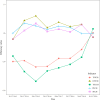Assessing healthcare efficiency and determinants in China: the perspective of provincial-level social health expenditure
- PMID: 40264128
- PMCID: PMC12013055
- DOI: 10.1186/s12913-025-12767-w
Assessing healthcare efficiency and determinants in China: the perspective of provincial-level social health expenditure
Abstract
Objective: Social healthcare expenditure is a crucial component of global healthcare expenditure. Assessing the relative efficiency, dynamic changes, and influencing factors of province-level social investment in China would facilitate the continued and stable development of healthcare services.
Methods: Based on the Malmquist Data Envelopment Analysis and Tobit regression model, this study pursued panel data from 2012 to 2020 for a set of 31 provinces and cities in China to estimate the efficiency of social health expenditure and explore the factors that influence the efficiency.
Results: All provinces experience a decline in the total factor productivity change index in the period 2012-2020. The average value is 0.917, which implies a deterioration of 8.3% per year. Most provinces show increased efficiency change but experience declines in technical progress, except Sichuan, Guangdong, and Shandong. Although efficiency change shows an upward trend, the positive impact is offset by technological regression, leading to a decline in overall productivity. Population density and urbanization level are found to be associated with expenditure efficiency in opposite directions. Higher levels of urbanization are associated with higher efficiency scores and the opposite impact is observed for population density.
Conclusions: This study shows that there is still much room for improving the efficiency of province-level social health expenditure and reinforcing the imperatives to increase investment in technological progress in health to foster the efficiency of social healthcare expenditure. Policy reforms and adjustments tailored to the specific conditions of different regions may be necessary for better alignment.
Keywords: DEA; Efficiency; Malmquist; Social health expenditure.
© 2025. The Author(s).
Conflict of interest statement
Declarations. Ethics approval and consent to participate: Not applicable. Consent for publication: Not applicable. Competing interests: The authors declare no competing interests.
Figures
Similar articles
-
Efficiency analysis of primary health care resources: DEA and Tobit regression evidence from village clinics in Jiangsu Province.Front Public Health. 2025 Apr 23;13:1515532. doi: 10.3389/fpubh.2025.1515532. eCollection 2025. Front Public Health. 2025. PMID: 40337730 Free PMC article.
-
Health system productivity in China: a comparison of pre- and post-2009 healthcare reform.Health Policy Plan. 2020 Apr 1;35(3):257-266. doi: 10.1093/heapol/czz157. Health Policy Plan. 2020. PMID: 31828335
-
The Regional Total Factor Productivity Changes of Healthcare Delivery in China: A Bootstrap Malmquist Data Envelopment Analysis.Inquiry. 2024 Jan-Dec;61:469580241266373. doi: 10.1177/00469580241266373. Inquiry. 2024. PMID: 39066676 Free PMC article.
-
The efficiency of provincial government health care expenditure after China's new health care reform.PLoS One. 2021 Oct 13;16(10):e0258274. doi: 10.1371/journal.pone.0258274. eCollection 2021. PLoS One. 2021. PMID: 34644313 Free PMC article.
-
Has the Efficiency of China's Healthcare System Improved after Healthcare Reform? A Network Data Envelopment Analysis and Tobit Regression Approach.Int J Environ Res Public Health. 2019 Dec 2;16(23):4847. doi: 10.3390/ijerph16234847. Int J Environ Res Public Health. 2019. PMID: 31810260 Free PMC article.
References
-
- Organization WH. A vision for primary health care in the 21st century: towards universal health coverage and the sustainable development goals. In.: World Health Organization; 2018. - PubMed
-
- Flessa S. Investing in health: overcoming the poverty trap by effective and efficient health care. J Public Health. 2007;15(6):415–21.
-
- Kerr R, Hendrie DV. Is capital investment in Australian hospitals effectively funding patient access to efficient public hospital care? Aust Health Rev. 2018;42(5):501–13. - PubMed
-
- Hale T, Angrist N, Kira B, Petherick A, Phillips T, Webster S. Variation in government responses to COVID-19. Version 6.0. Blavatnik School of Government Working Paper. 2020.
MeSH terms
LinkOut - more resources
Full Text Sources
Medical



